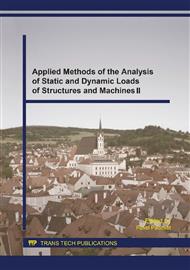p.73
p.77
p.83
p.87
p.91
p.95
p.99
p.105
p.109
Enhanced Frequency Response Function Technique as Tool for Mode Separation in Experimental Modal Analysis
Abstract:
The paper deals with mode separation process in experimental modal analysis. The main role in this process plays a technique known as Enhanced Frequency Response Function (EFRF), which allows separate the different modes of a structure. The results of the separation are responses of isolated systems with one degree of freedom by means of which complex poles can be estimated with greater accuracy. The paper describes the basic principle of EFRF technique and also presents its application in experimental modal analysis.
Info:
Periodical:
Pages:
91-94
Citation:
Online since:
February 2016
Authors:
Price:
Сopyright:
© 2016 Trans Tech Publications Ltd. All Rights Reserved
Share:
Citation:


